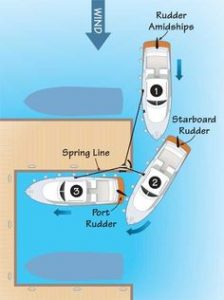Forespar's Point of View
Blogging About Life on the WaterMonthly Archives: July 2018
Six Timeless Seamanship Lessons
Beginning in the 50’s, BOATING magazine featured seamanship advice articles, many of which are applicable and basic today. Here is sampler
Have a Plan B
From January 1958: Unless you know firsthand that all your passengers are skilled at boating, assume they know nothing of what goes on between the gunwales. Robberson suggests that you assign each crew member a different task, giving each a role to play on board. Have one handle cushions and life jackets, for example, another to help with the dock lines, and another to help with engines and helm . That way, everyone has a specific task when you need help. From the time they board the boat, you can get them interested in doing things, and they’ll not only be better company and enjoy the ride more, but they’ll be good for something in an emergency.
Lights
From 1960: In daylight objects around you are usually easy to identify. They are big or small, short or tall, round or square, and they are plain to see as bridges, docks, land, beacons, buoys, or boats of various kinds and sizes heading one way or the other. But, at night, all the familiar shapes disappear, and all that’s left are various and sundry points of light: Some white, some green, some red, some orange, some blinking, some constant, some stacked, some horizontal, some moving, some still. If you can’t read these, lights, you should be ashore, preferable at home, learning navigation lights. The alternative can be bad.
Anchors “Away”
From 1977: Ellen Matthew wants you to think about scope – the length of anchor rode you have out under various conditions. With a short scope, the holding of even the best and heaviest anchor is reduced, because the high angle of the rode tends to pull the anchor up instead of along the bottom, breaking it loose. Coast Guard and Navy tests show that a scope of 7 to 1 is right for average conditions (in 10 feet of water, you want 70 feet of rode), at least 5 to 1 for ideal conditions (a calm lake or currentless harbor), and at least 10 to 1 during a blow.
Do No Harm
From 1983: Right of Way – Don’t hit any or anything, and don’t get hit. People often forget that boats don’t have brakes. So, simply put, the more maneuverable vessel stays out of the way of the less maneuverable. Sailboats watch out for rowboats, powerboats watch out for sailboats, and we all watch out for work boats. Like wise, our smaller craft are supposed to give way to ships, especially in tight quarters, because we can get out of their way easier than they can get out of ours. Know the rules and regulations, but be ready to dodge when boats meet. Remember the Law of Tonnage – if they’re bigger than you, being right may not be worth it.
Spring Line Docking
From 1998: Sailboats go bow in. Powerboats back in. We have a tradition to uphold. And remember sneaky trick #110. When the wind and/or the current are stacked against you, use the spring line method. Lay the boat along the pilings at the end of the dock, or along the end of the dock itself, with the stern (or bow) protruding into the slip. Wrap the line around the midships cleat and then loop around the cleat on the dock, or the piling. Turn the wheel toward the dock, and set the line tight until the bow (or stern) begins to work around, and then ease off as the end of the boat swings into the slip – and you’re home free.
There’s the old saying about docking. “Go slow like a pro, or fast like an ass”. Slow and steady gets you in with no damage – boat or brain.
